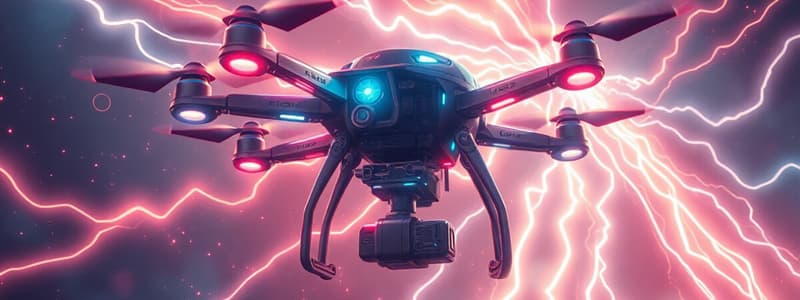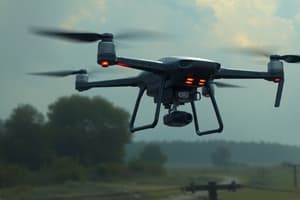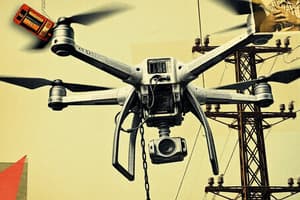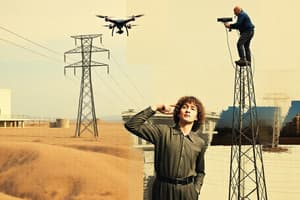Podcast
Questions and Answers
What is the primary limitation that Professor Ebeid's team is trying to address with their drone technology?
What is the primary limitation that Professor Ebeid's team is trying to address with their drone technology?
- The high cost associated with drone manufacturing.
- The drone's inability to fly at high altitudes.
- The limited battery life of current drones. (correct)
- The lack of radar sensors and cameras on existing drones.
How does the drone developed by Professor Ebeid's team recharge its batteries?
How does the drone developed by Professor Ebeid's team recharge its batteries?
- By landing at a designated charging station.
- By connecting to overhead power lines using a gripper. (correct)
- By swapping its depleted battery for a fully charged one.
- By using solar panels to convert sunlight into energy.
Which of the following steps describes how the drone achieves the recharging process?
Which of the following steps describes how the drone achieves the recharging process?
- The drone hovers around a charging station before initiating wireless charging.
- The drone uses radar sensors and cameras to locate a power line, then attaches via a gripper. (correct)
- The drone uses GPS to locate the nearest charging station before landing.
- The drone uses visual sensors to identify a suitable landing platform.
What potential application of the drone technology is Professor Ebeid particularly enthusiastic about?
What potential application of the drone technology is Professor Ebeid particularly enthusiastic about?
What is the main advantage of using Professor Ebeid's drones for power line inspections compared to current methods?
What is the main advantage of using Professor Ebeid's drones for power line inspections compared to current methods?
Flashcards
Drone Power Line Recharging
Drone Power Line Recharging
Drones can now recharge from power lines using radar and cameras to locate and connect via a gripper.
Developer of Drone Recharging
Developer of Drone Recharging
Professor Emad Ebeid and his team developed drone power line recharging technology.
Traditional Power Line Inspection
Traditional Power Line Inspection
Current power line inspections rely on helicopters and ground crews, which are inefficient and expensive.
Prototype Drone's Performance
Prototype Drone's Performance
Signup and view all the flashcards
Benefits of Drone Inspections
Benefits of Drone Inspections
Signup and view all the flashcards
Study Notes
- Modern drones' capabilities are often limited by battery life.
- Professor Emad Ebeid and his team at the University of Southern Denmark have developed a technology that allows drones to recharge from power lines.
- When the drone's battery is low, it uses radar sensors and cameras to locate the nearest power line.
- The drone attaches itself to the power line with a specially designed gripper.
- A magnetic circuit activates, allowing the drone to draw power.
- The recharging process is similar to wireless phone chargers.
- The drone was unveiled in March 2024 at the IEEE International Conference on Robotics and Automation.
- A 9. 5-pound (4. 3 kg) prototype successfully recharged five times and stayed airborne for over two hours in tests.
- Professor Ebeid envisions these drones revolutionizing industries, particularly power line inspections and maintenance.
- Using drones for power line work will improve efficiency, reduce costs, and enhance safety compared to current methods using helicopters and ground crews.
Studying That Suits You
Use AI to generate personalized quizzes and flashcards to suit your learning preferences.





